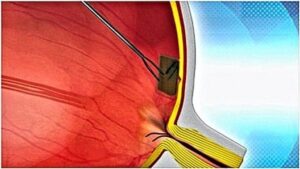Bio-Retina restores vision to AMD sufferers almost immediately following the simple implantation process
At least 25-30 million people worldwide have age-related macular degeneration (AMD), one of the leading causes of blindness in middle-aged and older adults. Israeli start-up Nano Retina has announced its new Bio-Retina, a tiny array of photodetectors which can be implanted directly on the retinal surface. Ready to enter clinical trials in 2013, the Bio-Retina restores vision to AMD sufferers almost immediately following the simple implantation process.
The retina is a light sensitive tissue lining the inside rear surface of our eyes. Retinal tissue is layered, where the photoreceptors of the eye (rods and cones) are located beneath several layers of neurons and ganglia interconnected by synapses. These neurons transmit the image to the optic nerve, and the ganglia perform low-level processing of the visual information.
AMD is caused by deterioration or breakdown of the retina’s central region, which is called the macula. It is a small area in the retina that is responsible for a person’s central vision and which allows you to see fine details. AMD progressively destroys the ability of the rods and cones to convert light into signals transmitted along the optic nerve. A retina affected by AMD still has fully functional optic nerves, as well as the retinal subsystems which feed neural signals from the rods and cones into the optic nerve. But when the rods and cones are inactive, there are no light-generated neural signals for the rest of the retina to transfer. AMD patients often retain some peripheral vision, but their central vision usually disappears completely in time, resulting in legal blindness. Total blindness is also common. There are currently no effective treatments for AMD.
Bio-Retina
Nano Retina has now developed the Bio-Retina – a tiny (3 x 4 mm) microchip implant that is inserted into the eye and glued to the retina in a minimally invasive procedure. It does not treat AMD, but rather seeks to relieve the blindness resulting from AMD. A small slit is cut in the eye under local anesthesia, and the implant is inserted and pressed against the damaged macula.
via Gizmag – Brian Dodson
The Latest Streaming News: age related macular degeneration updated minute-by-minute








